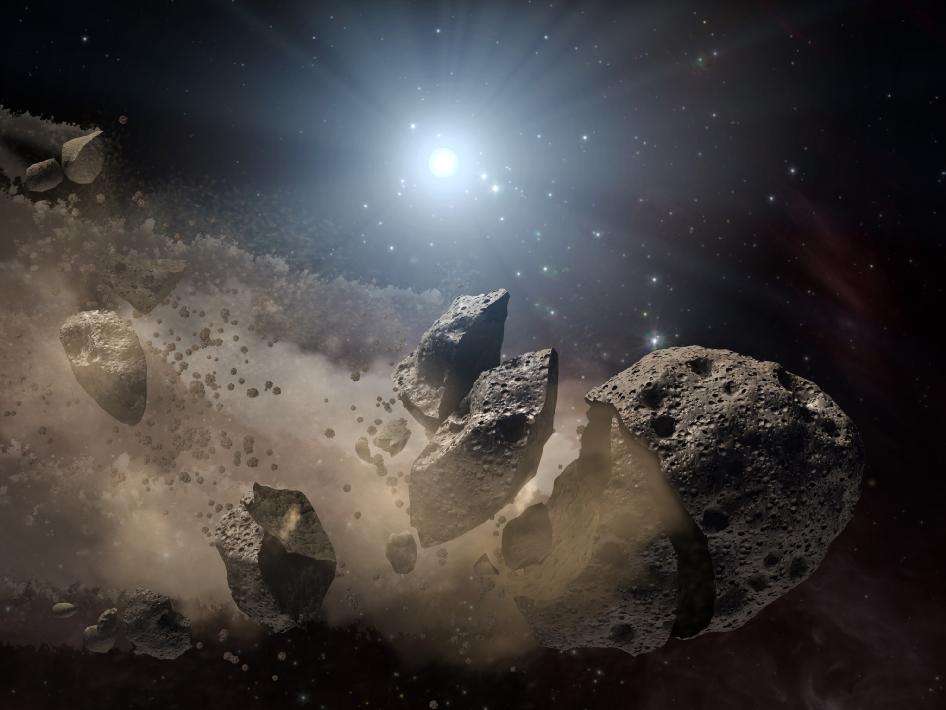Daniel Kirkwood (en 1876, 1890 et 1891), Felix Tisserand (1891), et Jean Mascart (1872-1935) étaient parmis les premiers astronomes à étudier des familles d’astéroïdes. Mascart était un astronome français qui travaillait à l’Observatoire de Paris pendant que cet établissement était sous la direction de Félix Tisserand. Mascart a publié les résultats de ses recherches (en 1899 et 1902) bientôt après la mort de Tisserand. Ces recherches indiquaient qu’il exitait des groupes dyamiques de deux ou trois astéroïdes, (c’est-à-dire des ensembles de planètes mineures partageant des propriétés orbitales voisines découlant de phénomènes purement dynamiques).
The rate of asteroids discovered increased, and by 1922 altogether 933 main belt objects had been found. Hirayama continued his researches and in that year he showed the number of families was at least five. He identified the groups and member numbers as: Koronis (13); Eos (19); Themis (22); Maria (13); and Flora (53). A few years later, in 1927 when a total of 1025 asteroids were known, he extended the families to include a sixth group and the ‘set’, with member numbers, became: Koronis (20); Eos (27); Themis (32); Maria (14); Flora (63) and now Phocaea (11).
Research was continued by several astronomers, especially the Dutch astronomers Dirk Brouwer (b.1902 d.1966) and Jos van Woerkom (b.1915 d.1991). Their results, based on 1537 asteroids, used the, then available, more accurate assessment of planetary perturbations. The original families detected by Hirayama were confirmed and 19 additional families identified (with a minimum of five individual asteroids). Brouwer also identified that the Flora group could be subdivided into four sub-sets.
Further dynamical and mathematical analyses were undertaken through the 1960s and 70s with both advances in analysis and observational techniques being made by several astronomers, and this refinement and expansion of asteroid families continues. The ‘original’ Hirayama families are now known to comprise many hundreds of individual asteroids. Up to today, 115 families have been identified, comprising > 121,000 individual members. Current methods for the determination of family membership involves both dynamical, orbital, assessment and subsequent assessment of the physical parameters of absolute magnitude, albedo and colours/spectral features.
As befitting their pivotal research, the asteroids 1999 Hirayama (1973 DR), 1746 Brouwer (1963 RF) and 4296 van Woerkom (1935 SA2) were named to recognise the results of the early researchers. Long overdue, Mascart has yet to have an asteroid named after him!
Bringing us very much up to date, the discovery of Oumuamua in 2017 unexpected showed that this object was the first detected interstellar asteroid. This strange, and strangely shaped, object was a transient visitor to our solar system (is on a hyperbolic orbit with respect to the Sun) and was a remarkable, and very much expected discovery.
Following this discovery, the French & Brazilian astronomers Namouni and Morais undertook a dynamical study into the Centaurs. Their work has shown that a subset of the Centaurs were most likely captured very early on in the lifetime of the Solar system. These (19) objects are on very high orbital inclinations and would appear to be have originated from the region beyond the scale of the primordial solar system. Most stars are formed in clusters so we may have inherited these objects from one of the Sun’s formation-companions.
https://ras.ac.uk/news-and-press/research-highlights/interstellar-asteroids-found-hiding-plain-sight
The key thing about asteroid families is that they can be used to show not only the dynamical relationships between the population of asteroids, and so gravitation and collision relationships within the group, but also can serve to support models of the formation of the solar system. Were the asteroids formed in-situ and never coalesced to form larger planetesimals? Or were a number of larger planetesimals formed (such as the residual ‘fortunate’ larger objects such as Ceres, Vesta and Pallas which remained intact due to early larger size and accumulative rather than erosive collisions) and later disintegrated by catastrophic collision events? We will consider this further in a future blog.
Next month.
We have thus far looked at the classifications and orbits of the asteroids. Our series will now move on to looking at the nature of the asteroids and their physical compositions. We’ll start next month by looking at their rotation rates and albedos.


